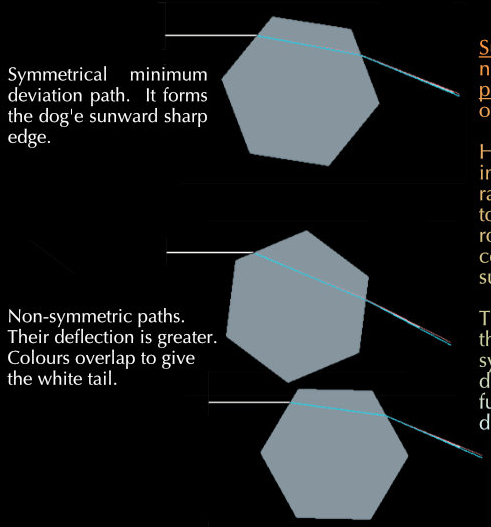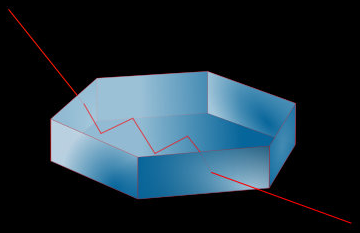Sundog white tails
Sundog White Tails: Unveiling the Mysteries of Atmospheric Optics
Have you ever gazed up at the sky and been captivated by the stunning display of sundogs? These celestial phenomena, also known as parhelia, are created by the interaction of sunlight with ice crystals high up in the atmosphere. While sundogs are well-known for their vibrant colors and bright sunward edges, there is an often-overlooked feature that adds an extra touch of enchantment to these optical wonders: their white tails.
Sundogs, or parhelia, possess white tails that can sometimes go unnoticed due to their merging with the parhelic circle. These white tails result from the overlapping of colors within the sundog. It is essential to understand the intricate mechanisms behind the formation of these white tails to fully appreciate the complexity of atmospheric optics.
The formation of a sundog begins with plate-shaped ice crystals found in cirrus clouds located high in the atmosphere. When sunlight passes through these crystals, it typically follows a symmetrical path, neatly parallel to a crystal's side face. This symmetrical route, known as the minimum deviation condition, produces the sundog's distinct bright sunward edge.
However, the story doesn't end there. When the crystal is rotated, the path of the sunlight becomes non-symmetric, resulting in a greater deflection of the rays. As a consequence, these rays appear further away from the sun. Moreover, rays of different colors overlap within the crystal, giving rise to the creation of white tails within the sundog.
Interestingly, the behavior of sunlight passing through the ice crystals is not limited to straight paths. When the sun is not near the horizon, the rays reflect up and down between the large top and bottom faces of the crystals before emerging. This reflection phenomenon adds further complexity to the formation of sundogs and contributes to the intricate patterns observed in their white tails.
To fully comprehend the science behind sundog white tails, it is crucial to appreciate the interplay between the geometry of the ice crystals and the path of sunlight passing through them. By studying the various routes taken by the rays within the crystals, scientists gain valuable insights into the intricate nature of atmospheric optics.
In summary, sundog white tails are a captivating aspect of atmospheric optics that adds an extra layer of beauty to these celestial phenomena. The overlapping of colors within the ice crystals, combined with the rotation and deflection of sunlight, creates intricate patterns and mesmerizing displays in the form of white tails. Understanding the complexities behind these optical wonders not only enhances our appreciation for the natural world but also sheds light on the fascinating science of atmospheric optics. Next time you spot a sundog in the sky, take a moment to marvel at its white tail and the intricate dance of light and ice occurring high above us.

Industrial Sundog A bright sundog with a long white tail pictured at a Budapest, Hungary railway station by Tamas Abraham.
Symmetrical minimum deviation path. It forms the dog'e sunward sharp edge.
Non-symmetric paths. Their deflection is greater. Colours overlap to give the white tail.

Sundogs have white tails often notnoticed because they merge into the parhelic circle. The white comes from overlapping colours.
Horizontal plate shaped crystals high in cirrus cloud form sundogs. The sun's rays are usually shown neatly parallel to a crystal side face. This symmetrical route is the minimum deviation condition producing the dog's bright sunward edge.
There are many more routes. Rotate the crystal and the ray path is no longer symmetric and importantly - the ray's deflection is greater. These rays appear further from the sun. The rays of different colours overlap to give white.

And that's not all. Rays only pass straight through the plates when the sun is near the horizon.
At other times they reflect up and down between the large top and bottom faces before emerging.

Note: this article has been automatically converted from the old site and may not appear as intended. You can find the original article here.
Reference Atmospheric Optics
If you use any of the definitions, information, or data presented on Atmospheric Optics, please copy the link or reference below to properly credit us as the reference source. Thank you!
-
<a href="https://atoptics.co.uk/blog/sundog-white-tails/">Sundog white tails</a>
-
"Sundog white tails". Atmospheric Optics. Accessed on December 21, 2024. https://atoptics.co.uk/blog/sundog-white-tails/.
-
"Sundog white tails". Atmospheric Optics, https://atoptics.co.uk/blog/sundog-white-tails/. Accessed 21 December, 2024
-
Sundog white tails. Atmospheric Optics. Retrieved from https://atoptics.co.uk/blog/sundog-white-tails/.